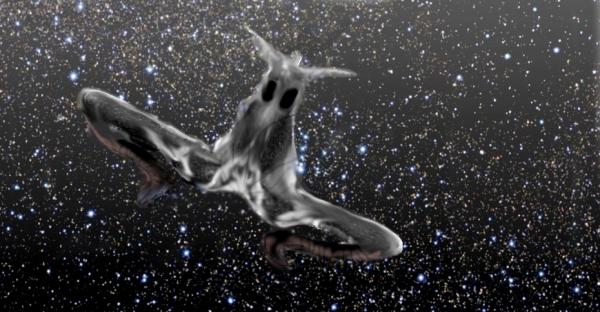BY LETTER
Dead Drifter
Xenosophont species known only from a single space burial |
 Image from Steve Bowers |
The Dead Drifter" is the nickname given to a deceased xenosophont found drifting through space in Sagittarius, during the late First Federation Age, the only recovered specimen of the (presumably) extinct alien species HIE091MZE.
In 1956 a.t, a Neumann explorer visited JD 100401510, a K-type main sequence star orbited by three hot Jovian worlds. While exploring the system's Oort cloud, the probe encountered a small, black object drifting through space. This object (the so-called "coffin-suit") consisted of several layers of polymer and lead, and contained biological remains. Although these remains were initially thought to belong to a member of an unknown Terragen clade, they were later reliably dated to approximately 190 million years before present, meaning that they were definitely of non-Terragen origin. When news of the find reached larger civilization, it caused great excitement in the xenological community, who made numerous attempts to determine the system of the creature's origin. Although the three worlds in the JD 100401510 system were surveyed extensively, they were not found to contain any additional evidence of past alien activity.
Unsurprisingly, it was not just xenologists interested in this find, and it seemed that sophonts of all known clades and species were eager to learn more about the mysterious alien. One important news source of that era nicknamed the creature "the Dead Drifter", a term which quickly became popular, and has endured to the Current Era. The prevailing theory amongst xenologists was that the entity belonged to a species originating in another part of the galaxy, had died at some point during an interstellar voyage, and was placed in a "coffin-suit", which was then ejected from the spacecraft. However, many conspiracy theorists supported the idea that the Drifter was left in space by the mythical Dawn Hunters. It was suggested that the Drifter may have belonged to a rapidly expanding civilisation which was wiped out by the Hunters, its final remains left to drift through the void as a warning to other species. However, this idea was rejected by the major xenological Institutes. The "Dead Drifter" and other members of its species made a number of appearances in popular virch media of the time, with the Drifter itself sometimes being depicted as a downed alien hero, other times as a monstrous villain, waiting to be revived by eir followers.
It should be noted that not long after the Drifter was found, there were a number of attempts made to recreate its species. However, even the coffin-suit was ultimately unable to protect the body within from slowly decaying over tens of millions of years. Unfortunately for the lazurogenists, little beyond basic physiology and biochemical clues remained of the specimen. Nonetheless, a number of (highly hypothetical and diverse) reconstructions were made, forming the so-called "Resurrected Drifter clades".
Resurrected Drifters have since gone on to colonise many worlds and habs across the Terragen Sphere. A common story amongst some Drifters tells of how an ancient alien hero was killed in an interstellar war, its body launched into space so that its people might be recreated in the distant future. Others believe the Dead Drifter to be the discarded body of the first transapient to emerge in the universe, or else the last remaining specimen of the Dawn Hunter creators. Additionally, many Drifters (particularly those interested in mythology and the occult) choose to be buried in a way similar to the Dead Drifter, placed in a coffin-suit and launched into space. This method of burial has also become commonplace in other cultures since the Drifters' discovery.
Related Articles
Appears in Topics
Development Notes
Text by James Rogers
Initially published on 29 February 2016.
Initially published on 29 February 2016.






